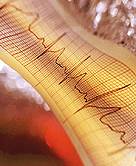2-in-1 Test Signals Risk After Heart Attack
It measures nervous system and heart's electrical system.
By Ed Edelson
HealthDay Reporter
|
E-mail this article
Subscribe to news
Printer friendly version
|

(SOURCES: Derek V. Exner, M.D., associate professor of medicine, University of Calgary, Canada; David S. Rosenbaum, M.D., professor, medicine and biomedical engineering, Case Western Reserve University, Cleveland; Dec. 11, 2007, Journal of the American College of Cardiology)
TUESDAY, Dec. 4 (HealthDay News) -- A test of two heart functions accurately spotted patients at highest risk of cardiac arrest or death as they recovered from a heart attack, Canadian researchers report.
"This is important because past studies, focusing on a single test, failed to identify most people at risk," said study lead author Dr. Derek V. Exner, associate professor of medicine at the University of Calgary. "We developed a simple method of identifying approximately twice as many people at risk. That means we can potentially save more lives."
The tests used in study are available now, although they aren't widely used, Exner said. "Theoretically, we can do them today if we chose to," he said. But the plan is to wait for the completion of additional trials, such as two large-scale studies now in the planning stage.
In the study, Exner and his colleagues had 322 people wear monitors for 18 to 24 hours a day, starting two to four weeks after they had suffered a heart attack. The researchers looked at the electrocardiograms recorded by the devices for an abnormality in heart rhythm called T-wave alternans, a symptom so subtle it can be detected only by computer analysis.
In addition to that measure of heart function, the electrocardiograms were also analyzed for the presence of heart rate turbulence, an abnormality of the autonomic nervous system that controls heart function.
Starting at 10 to 14 weeks after the heart attack, the presence of the two abnormalities clearly identified persons at increased risk. The 20 percent of study participants who had both abnormalities had more than six times the risk of cardiac arrest or death than other people in the study, the researchers said.
The findings are published in the Dec. 11 issue of the Journal of the American College of Cardiology.
Previous studies have shown that one abnormality or the other can increase cardiovascular risk, said Dr. David S. Rosenbaum, professor of medicine at Case Western Reserve University, who first reported on T-wave alternans in 1994.
"This is where this paper extends our knowledge," Rosenbaum said. "It shows that the two [irregularities] have a synergistic effect in a post-myocardial infarction [heart attack] population."
One application of the two-in-one testing could be in selecting persons who would be best helped by an implantable defibrillator, a device that delivers a shock to keep the heart beating normally when necessary. In the majority of cases today, Rosenbaum said, an implanted defibrillator just sits in the chest, because its emergency activity is never needed.
Exner said: "We have two large studies planned. One is where we have patients who are not indicated for defibrillators post-MI [myocardial infarction]. It is starting in May. The other study will include patients getting defibrillators because of a low ejection fraction," a weakened ability to pump blood.
Until these and other studies are done, "it's too early to start making treatment decisions" on the basis of the two combined tests, Exner said.
Rosenbaum said the new study does show "that when you combine these tests, you get a fairly robust prediction of outcomes. But like all good studies, it raises a lot of questions. It also requires validation in prospective trials."
More information
To learn more about implantable defibrillators, visit the American Heart Association. 
Copyright © 2007 ScoutNews, LLC. All rights reserved. 
HealthDayNews articles are derived from various sources and do not reflect federal policy. healthfinder.gov does not endorse opinions, products, or services that may appear in news stories. For more information on health topics in the news, visit the healthfinder.gov health library.